THEY'RE HIP
A Survey of
Sliding Straps
By MIKE PASINI
Editor
The Imaging Resource Digital Photography Newsletter
Review Date: July 2012
Updated: October 2012
After our review of the Custom SLR M-Plate Pro, in which we tried the company's lightweight Glide Strap, we heard from several strap designers.
"Try our strap!" they all suggested.
While we found the Glide Strap comfortable and functional, we're not a fan of straps. We liked them just fine when we shot with them in the bunker for this review but we were never comfortable transporting a camera with them. Getting in and out of a car or bus, say, or hiking up a hill carpeted in tall grass, quickly reveal the problem.
We've solved that by using a holster bag (like the Lowepro TLZ1 or, for larger gear, the Think Tank Digital Holster 40) or a small camera bag (like the Think Tank Retrospective 5 or the somehow unretirable Domke) for transport. That has the added advantage of hiding the camera from view in public, a safety concern of ours. When we take the camera from the bag, we use a small wrist strap from UPstrap we can easily share among our cameras (see the March 23, 2012 issue of the Newsletter).
But if you find yourself in one locale in which you have to continually pick up and put down the camera, a strap lets you leave it at your side and quickly slide it into action like nothing else.
That's because, as BosStrap inventor Tom Fama puts it, "Sliding sling straps use a special fitting that moves along the diagonal strap, not requiring the strap itself to move." It's a smooth, effortless glide to your eye.
We find that a little more convenient if slightly less secure than the pin and holster arrangements we reviewed in the April 8, 2011 Newsletter.
So the usefulness of a strap depends on how you shoot. That's the first lesson.
Besides the Glide Strap, we tried several other straps. Here's the full list:
- BosStrap G3 $47.95
- BlackRapid RS-Sport $69.95
- BlackRapid RS-W1 for women $58.59
- Carry Speed DS-Slim $49.99 and FS-Pro $69.99
- Custom SLR Glide Strap with C-Loop $64.95
- Cotton Carrier StrapShot $79
We didn't test the simple but popular $60 Sun-Sniper. If you're shopping, add it to your list. It has probably the simplest connector to the camera.
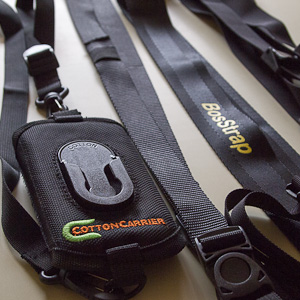
Straps. Different widths, different weaves, different mounting systems.
GENERAL OBSERVATIONS | Back to Contents
One thing immediately stood out. With the exception of the BlackRapid RS straps, documentation was poor.
You might wonder just how tough it is to sling a strap across your chest and screw a bolt into the tripod socket of your camera or attach the BosStrap to the camera eyelet. But there are slide limiters to figure out and other issues that could be clarified with a simple instruction sheet.
The straps come with at least one limiter or bumper that prevents the slide from continuing along the strap. That limiter is handy behind the slide to prevent the camera from getting behind your back. It's not a lot of help up front because you want the camera to slide up your chest. But a front limiter with a rear limiter can "lock" the camera on the strap so it doesn't slide. But it will still swing around.
Annoyingly enough, the most convenient hanging position (or strap length) always seemed to let the camera LCD rub against the grommets of our jeans. Ideally, you'd like the camera's left side (without the grip) to fall against you, leaving the grip exposed for you to grab.
You might think a sliding strap is a good solution for having more than one camera at the ready. We found that a little more than awkward. There are two-camera harnesses around and Cotton Carrier offers a more customizable approach. But two sliders is not a good idea.
While not immediately apparent, there was another issue that struck us. These things are not inexpensive. And a quick price comparison suggests why. The BosStrap, which does not require a metal tripod mount, is the least expensive. Models that use a machined mounting device nearly double the cost.
Finally, these straps may not look like it but they're all are designed to handle heavy gear. A full frame dSLR with a long zoom lens, say. They aren't in any sense restricted to such use but that seems to increase their utility.
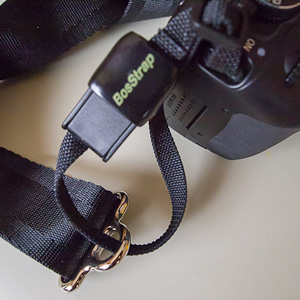
BosStrap. It attaches to the eyelet with a unique tail strap. Safety sleeve is printed with name and covers the cam buckle.
So let's take a closer look at the price leader, the BosStrap G3. It consists of a one and half inch wide sling strap (the widest) and a G3 (third generation) BosTail tail that attaches to a camera eyelet.
The G3 tail can be detached from the strap. That addresses our transport concern to some extent. You can toss the camera in a bag, leaving the strap on and in fact wrapping around a long lens so it isn't in the way.
The main argument for the BosStrap is that it attaches to an eyelet instead of the tripod socket. We're sympathetic to that argument (we have other things to do with our tripod socket) but not because we believe tripod sockets are weaker than eyelets.
Unfortunately, we found the tail something of a nuisance. Threading eyelets is annoying. And threading eyelets and tails is doubly so. It's true that once attached, you can leave it there.
But if you want to detach the camera from the strap, you do have to slide off the safety sleeve and lift the cam buckle to slip the small strap out. That's a lot more work than releasing the Glide Strap's plastic buckle, for example.
Our quibbles about the tail aside, once you start using the BosStrap, it's pretty handy. We liked the wide, unencumbered, simple strap. It does indeed wrap around a long lens for transport or storage. And the simple chrome slider itself would have been our favorite if it hadn't been bright, shiny chrome. No need to get fancy with pads or limiters.
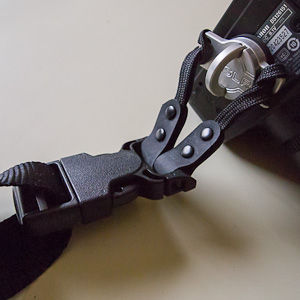
Glide Strap. We left the C-Loop handle raised so you can see how easy it is to screw it in. Buckle unsnaps from slide attached to strap.
CUSTOM SLR GLIDE STRAP | Back to Contents
The lightweight Glide Strap with the C-Loop uses a split strap design and a compact tripod mount that swivels easily. The C-Loop itself is nicely machined but uses two metal loops to attach to a rather complex buckle that ties onto a mounting screw with a folding handle you use to screw it into the tripod mount.
That complex buckle, though, makes it possible to detach your camera from the strap. The detachable buckle (just squeeze to release) has two small straps attached to it that go to each end of the mounting screw.
The mounting screw does occupy the tripod socket but Custom SLR has developed a plate system that accommodates both the mounting screw and a quick release tripod mount.
The split strap can ride on you shoulder at two different angles without biting into your shoulder. It also has some traction on the underside to prevent slipping. Oddly, it includes two plastic snaps to attach the belt to the ends of the pad. We suspect that's just a manufacturing solution because there's really no need for them in use.
The Glide Strap works fine even if it looks a little like Rube Goldberg was a design consultant. And it's lightweight, which we appreciated.
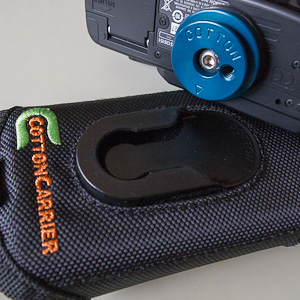
StrapShot. Not really a strap so much as a pad using the Cotton Carrier mount (blue) that you strap to something. Slip in, turn 90 degrees to lock.
COTTON CARRIER STRAPSHOT | Back to Contents
The StrapShot is unusual. Like other Cotton Carrier products, it relies on the Cotton hub and insert design. The insert attaches to the tripod socket on your camera and slides into the hub sideways. When you turn the camera 90 degrees to face down, the camera locks into the hub.
So there's no sliding with this model. Instead, the hub is mounted on a pad with a strap system that can be attached to a backpack or a Cotton Carrier vest.
Since you don't slide the camera, you detach it from the hub to shoot. But when mounted in the hub it's secure enough you won't feel the need to detach it during transport.
The trick is attaching it to something.
We asked Cotton Carrier just how it works and they replied, "It wraps around your backpack/sling bag strap and then tethers into the top of the bag to prevent the camera from slipping down the strap."
So you screw the mounting piece into the camera's tripod socket and put that down. Then you wrap the StrapShot hub (which sits in a 3x6-inch pad) around one of your backpack's straps. To keep it from slipping, you tie the top end to something above it on your backstrap.
We gave it the old college try on a Lowepro 150 AW video pack. The straps snug right up under our arms, which doesn't leave much room for a StrapShot. The illustrations on the Cotton Carrier site show the strap riding much closer to the center of your chest than our backpack strap does.
So we were mounting the camera a bit too close to our face for comfort. And it wasn't a large camera either.
We have no problem with the Cotton Carrier vest, which mounts the camera on your chest, but this arrangement with the StrapShot seemed a lot less comfortable. You can blame us for how we mounted it, if you like.

BlackRapid. Both models use the same triangular hook to screw system. A sleeve on the hook unlocks that side so you can slip the camera off the system.
BLACKRAPID RS-SPORT | Back to Contents
Compared to the other models, the BlackRapid RS looks overbuilt. But then it's designed for more action. The $69.95 RS-Sport 2 is a lighter version which includes one ConnectR-2 and one FastenR-3. You can buy additional FastenR-3s for other camera bodies.
The strap is constructed in several parts included a form-fitted padded shoulder piece that includes an accessory loop. There's also a small secondary safety strap that goes under your arm to keep the main strap in place.
It's designed to go over your left shoulder. The other straps don't insist on that but it's the most convenient arrangement anyway, considering the camera grip is on the right side of the camera.
The $11.95 ConnectR-2 connector itself is an attractive, polished metal construction of several pieces. A loop attaches (and is meant to remain attached) to the R-Strap, a triangular hook swivels where it attaches to the loop and opens to accept the $13.95 FastenR-3 round screw with a rubber gasket. BlackRapid suggests wetting the rubber gasket before tightening to make a better secure connection.
You can lock the triangular hook closed by twisting a small sleeve on the opening. So with this model, too, the camera can be detached for transport. Not quite as quickly as the Glide Strap's buckle, but fast enough.
Wearing the RS-Sport you feel well enough strapped up to take a space walk. With the limiters and the secondary safety strap, the camera is less likely to walk off without you, too.
BLACKRAPID RS-W1 | Back to Contents
The W1 model has been designed to more comfortably fit the female figure by curving along the neck and dropping straight down the chest rather than crossing the left breast directly or pressing against it like the StrapShot.
You'd think a gentleman who shares camera bodies with a lady would just opt for this model so both of them could use it. But BlackRapid has made the shoulder pad daintier and even embroidered some frilly patterns on it (which you can avoid with the W1B model). We tried it on ourselves but it really didn't fit.
Same strap and mounting hardware, though.
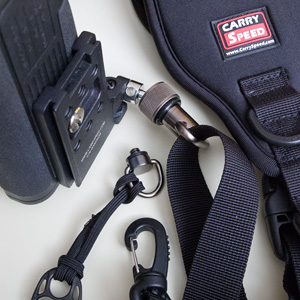
FS-Pro. The ball and socket mount screwed into our dSLR hand grip with Arca Swiss slots on the long sides, plus two accessory straps.
CARRY SPEED DS-SLIM, FS-PRO | Back to Contents
We tested two Carry Speed Sling Strap designs. The $44.99 DS-Slim is intended for lighter-weight gear like Compact System Cameras and digicams while the $69.99 FS-Pro, which includes a hand strap, handles dSLRs and heavy lenses with a unique mounting system that also provides for tripod mounting.
Both units were very well made and comfortable to wear. The DS-Slim uses a two-inch neoprene shoulder pad with a non-slip surface sewed into its underside. The FS-Pro has a three-inch neoprene shoulder strap that also has a non-slip surface on the inside.
Both are very light and both have plastic buckles that attach to a one-inch webbing on which the hardware glide travels. That makes them two-piece straps but it also provides for a quick adjustment feature. Just pull on the D ring to adjust the length of the strap.
Both Carry Speed straps use a ball and socket joint to attach the camera to the strap. The socket is on the strap and the ball is attached to the camera. At your side, the camera falls in a very comfortable offset position.
On the DS-Slim the ball sits on one end of mounting hardware that screws into the camera's tripod socket. A collar is drilled with a hole so you can insert an Allen wrench to tighten the rubber gasket against the bottom of the camera. It's a very secure arrangement.
On the FS-Pro, the ball is hinged to and swivels on a plate that is screwed to the camera's tripod socket again with an Allen wrench or with a coin. With the pin position at the front of the camera, swiveling it up provides a nice upright stand when you sit the camera down, detached or not. When swiveled to point down, it aligns the camera comfortably at your side, upside down and pointing backward, the hand grip on the outside ready for action.
The plate has grooves along its long sides to simulate an Arca Swiss tripod mount and six threaded holes to attach other quick release modules. In addition, it has a 3/4-inch slot to accommodate a strap.
That design reminded us of the Custom SLR M-Plate, which also accommodates both a strap and tripod.
The ball can be separated from the socket by unscrewing a sleeve that screws down over a slot in the socket. It isn't quick but it's secure. It isn't something we did very much with the DS-Slim because the detached camera still has the pin attached to the bottom of the camera. On the FS-Pro, though, the pin can be swiveled out of the way for tripod mounting or just to sit the camera down.
We did have a pretty deal-breaking problem with the ball and socket joint, though. Almost right away it began squeaking. As we walked around, a small chirp accompanied our every step. In fact, at first we thought it was a bird. But as we continued our hike, we realized there was no bird along for the ride. It was the ball scraping against the socket. The only way to stop it was to either add or relieve pressure on the joint by holding the camera.
We tried cleaning the ball and socket but that didn't help. What did help was applying a light coating of silicon spray. We wanted a lubricant that would not attract dirt, otherwise anything would do.
The FS-Pro can also hook up a three-quarter-inch strap to secure a long telephoto lens. That strap is included along with a small gasket-lined screw mount. Screw the mount into the lens tripod point, buckle the short strap to the short strap and attach that strap to the D-ring on the FS-Pro and you've got two anchors.
You can also swap out the short strap for the included hand strap, which fits snugly around your wrist with about six inches of free strap.
After using both straps for a couple of weeks, we have to say we like the design choices Carry Speed has made and appreciate the functionality of both socket systems. We're even inclined to leave the plate on our dSLR because it props it up off the lens when we put it down. It's a good, comfortable, cure strap with an unobtrusive tripod mounting system that doesn't bang against the camera body but holds the body in a ready to grab position.
Were we browsing in a camera shop, we wouldn't be able to tell by looking which of these straps we'd prefer. But oddly enough, even after using them for a while here, no preference established itself (except the W1 was too small for us).
They are different, no doubt about it. The straps vary in width and construction, some are padded, one split. The sliders are differently constructed using various materials from metal to plastic. Even the mounting hardware varied from tripod mounts to an eyelet mount.
But these are differences that, well, don't really matter.
Sure, you may prefer the split strap over a single belt or the wide single belt you can wrap around your lens to one that uses limiters. You may prefer the buckle release to the hook. You may prefer a metal slider to a plastic one. You may prefer a padded shoulder pad to a bare strap.
You may be one of those people who can argue all night about this stuff. But they do the job, keeping your camera handy and getting it quickly to shooting position.